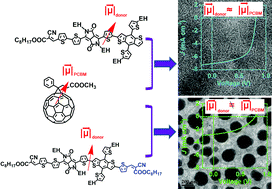Terminal moiety-driven electrical performance of asymmetric small-molecule-based organic solar cells†
Abstract
With respect to the successes from symmetric small molecules, asymmetric ones have recently emerged as an alternative choice. In this paper, we present the synthesis and photovoltaic properties of four asymmetric small molecule donors. The benzo[1,2-b:4,5-b′]dithiophene (BDT) end in the asymmetric push–pull CNR–DPP–BDT (CNR = octyl-2-cyano-3-(thiophen-2-yl)acrylate, DPP = diketopyrrolopyrrole) was tailored from hydrogen (H) to thiophene (T), 2-hexylbithiophene (HTT), and CNR, respectively, obtaining M1, M2, M3, and M4. In this order, the donor–donor interactions are enhanced with an increase of intermolecular forces, such as π–π-stacking and van de Waals forces, which enhances aggregation of the donor molecules. In parallel, the molecular dipolarity (|μ|) increases in this order from 5.39 D to 6.26 D, 6.34 D, and 6.92 D, respectively, gradually deviating from the value of PC71BM (5.01 D). The increase in the donor-to-PC71BM doplarity difference acts as another factor for enhancing the donor-to-PC71BM phase-separation. The donor/acceptor domain sizes increase from M1 (10 nm) to M2 (20 nm) and M3 (50 nm), and even formation of island-like mesostructured PC71BM aggregates (200 nm) for M4, corresponding to declined short-circuit current density (Jsc) and fill factor (FF) as well as hole mobility (μh) from M1 to M4. This work reveals that control over the terminal moieties of asymmetric small molecules can be an important factor in tailoring photovoltaic performance.



 Please wait while we load your content...
Please wait while we load your content...